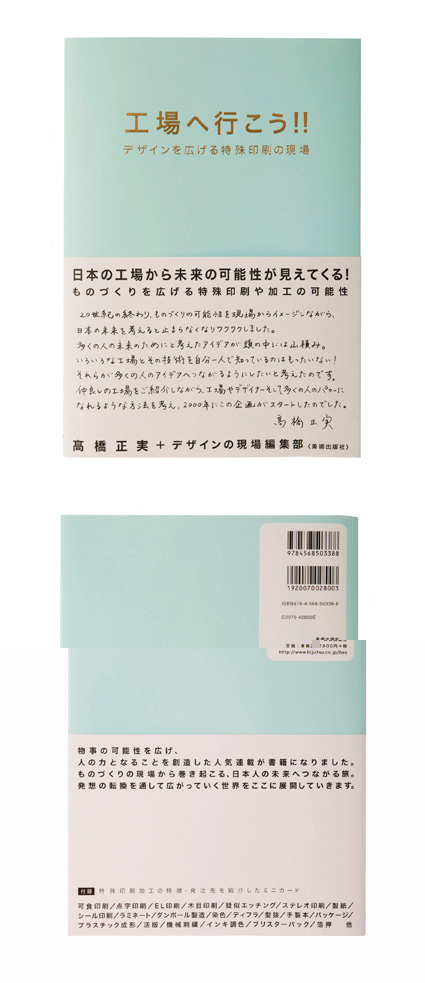"Let's Go to a Factory!!" (2008)
Client: Bijutsu Shuppan-sha Co., Ltd.
+ Click here to purchase
This is a book based on the series carried by the magazine "dezain no gemba (the frontline of design)" (Bijutsu Shuppan-sha) over 5 years and 2 months.
The series highlighted technical expertise that Japanese factories have and the potential of Japan's manufacturing based on Takahashi's ideas. As a result of carrying this series, her ideas led to cross-industrial connections, many people's expectations on factories and industrial power in Japan, the construction of a new area of special printing processing, the widespread dissemination of the concept of the special printing processing across design sites (what Takahashi dreamed about in those days), changes of factories, factories becoming open to the public, and society beginning to pay attention to Japan's manufacturing and power of factories. Even today, its impact remains strong to widely link the potential of factories and design sites, which is said to have resulted in the significant change in the relations between factories and designers.
The series started with the introduction of people whom Takahashi met in her teens and early twenties, and built relations with based on deep trust, which made this series possible. It was one of the projects to "root for Japan" that she thought of in those days. In a different age from now and when factories were more closed, factory people extended their help to each issue of this series only because of Takahashi's request; the content was thus hot thanks to their relationships based on deep trust.
In the series, techniques that she was engaged in in her teens were also described. As she made a tour of a lot of factories across the nation since she was in her teens until she graduated from Kuwasawa Design School, she came to want to "root for small- and medium-sized factories and industries in Japan through the power of design!!" The series is full of her connections with factories and their presidents and of ideas for the future of Japan, which were gaining momentum gradually, such as printing/processing techniques and methodological/material concepts.
In those days, Takahashi wanted to connect factories with designers and let as many people in the world as possible know that there were so many wonderful techniques, factories, and craftspeople in Japan. Manufacturing sites have techniques but ideas are a different story in some cases. Many people, including designers, think about things in the conventional paradigm, so if they are given a "hint," it will help people realize various possibilities and expand society and a large number of people will find an idea for the future that gains momentum; this is what she dreamed about in those days more than anything. She unveiled ideas that had yet to exist in the world in each issue, having a desire to show the future potential of Japan's manufacturing. This was presented in the form of a series like "Let's Go to a Factory!!," in which a wide variety of factories were spotlighted; it was quite a novel approach from a magazine publisher's perspective in those days. Through this series, she directed various images to many people's dreams in an exciting manner, which was a big deal for her.
In the series, how Takahashi visited a factory was dealt with from a perspective of a reader who visited it for the first time. In reality, however, she had close relations with people of the factory, who were introduced. Because of this background, this series was made possible.
Before the series was carried, "Because Masami-chan made a tour of factories many years ago, the factory community has really changed," people in the factory community said. It is no exaggeration to say that "Let's Go to a Factory!!" is the project she has put a lot of energies since she was in her late teens to give a boost to Japan's manufacturing. The book is her first step for the future of Japan.
+ Click here to purchase the book "Let's Go to a Factory!!" (Bijutsu Shuppan-sha)
Related page
> Columns







